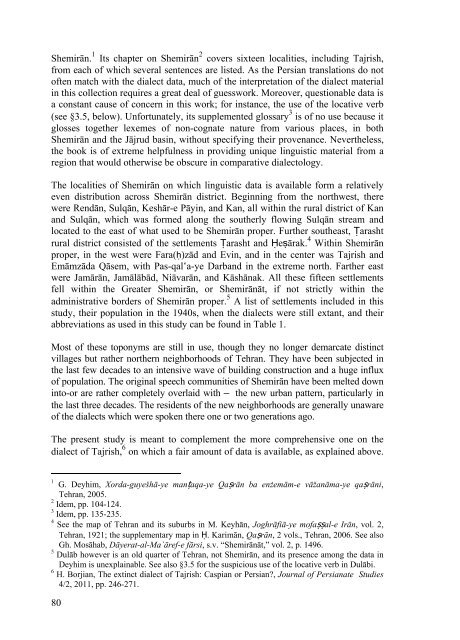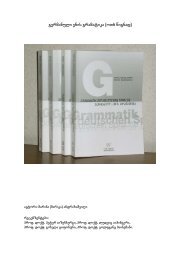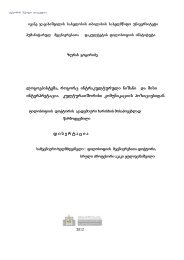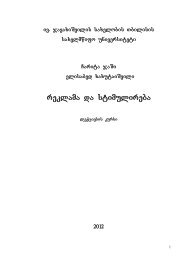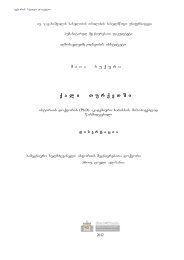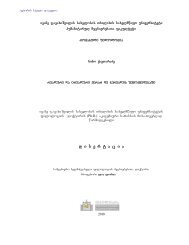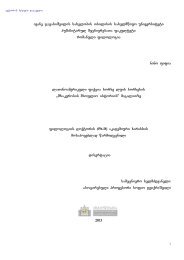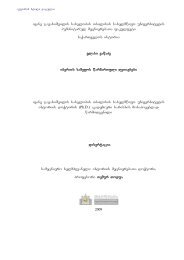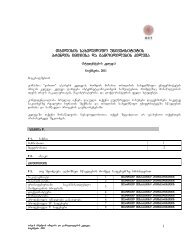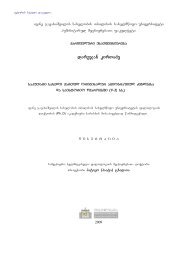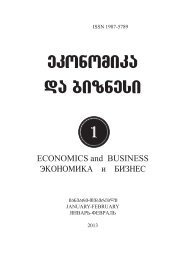issues of linguistics - Tbilisi State University
issues of linguistics - Tbilisi State University
issues of linguistics - Tbilisi State University
You also want an ePaper? Increase the reach of your titles
YUMPU automatically turns print PDFs into web optimized ePapers that Google loves.
Shemirān. 1 Its chapter on Shemirān 2 covers sixteen localities, including Tajrish,<br />
from each <strong>of</strong> which several sentences are listed. As the Persian translations do not<br />
<strong>of</strong>ten match with the dialect data, much <strong>of</strong> the interpretation <strong>of</strong> the dialect material<br />
in this collection requires a great deal <strong>of</strong> guesswork. Moreover, questionable data is<br />
a constant cause <strong>of</strong> concern in this work; for instance, the use <strong>of</strong> the locative verb<br />
(see §3.5, below). Unfortunately, its supplemented glossary 3 is <strong>of</strong> no use because it<br />
glosses together lexemes <strong>of</strong> non-cognate nature from various places, in both<br />
Shemirān and the Jājrud basin, without specifying their provenance. Nevertheless,<br />
the book is <strong>of</strong> extreme helpfulness in providing unique linguistic material from a<br />
region that would otherwise be obscure in comparative dialectology.<br />
The localities <strong>of</strong> Shemirān on which linguistic data is available form a relatively<br />
even distribution across Shemirān district. Beginning from the northwest, there<br />
were Rendān, Sulqān, Keshār-e Pāyin, and Kan, all within the rural district <strong>of</strong> Kan<br />
and Sulqān, which was formed along the southerly flowing Sulqān stream and<br />
located to the east <strong>of</strong> what used to be Shemirān proper. Further southeast, Ṭarasht<br />
rural district consisted <strong>of</strong> the settlements Ṭarasht and Ḥeṣārak. 4 Within Shemirān<br />
proper, in the west were Fara(ḥ)zād and Evin, and in the center was Tajrish and<br />
Emāmzāda Qāsem, with Pas-qal‛a-ye Darband in the extreme north. Farther east<br />
were Jamārān, Jamālābād, Niāvarān, and Kāshānak. All these fifteen settlements<br />
fell within the Greater Shemirān, or Shemirānāt, if not strictly within the<br />
administrative borders <strong>of</strong> Shemirān proper. 5 A list <strong>of</strong> settlements included in this<br />
study, their population in the 1940s, when the dialects were still extant, and their<br />
abbreviations as used in this study can be found in Table 1.<br />
Most <strong>of</strong> these toponyms are still in use, though they no longer demarcate distinct<br />
villages but rather northern neighborhoods <strong>of</strong> Tehran. They have been subjected in<br />
the last few decades to an intensive wave <strong>of</strong> building construction and a huge influx<br />
<strong>of</strong> population. The original speech communities <strong>of</strong> Shemirān have been melted down<br />
into-or are rather completely overlaid with _ the new urban pattern, particularly in<br />
the last three decades. The residents <strong>of</strong> the new neighborhoods are generally unaware<br />
<strong>of</strong> the dialects which were spoken there one or two generations ago.<br />
The present study is meant to complement the more comprehensive one on the<br />
dialect <strong>of</strong> Tajrish, 6 on which a fair amount <strong>of</strong> data is available, as explained above.<br />
1<br />
G. Deyhim, Xorda-guyešhā-ye manṭaqa-ye Qaṣrān ba enżemām-e vāžanāma-ye qaṣrāni,<br />
Tehran, 2005.<br />
2<br />
Idem, pp. 104-124.<br />
3<br />
Idem, pp. 135-235.<br />
4<br />
See the map <strong>of</strong> Tehran and its suburbs in M. Keyhān, Joghrāfiā-ye m<strong>of</strong>aṣṣal-e Irān, vol. 2,<br />
Tehran, 1921; the supplementary map in Ḥ. Karimān, Qaṣrān, 2 vols., Tehran, 2006. See also<br />
Gh. Mosāhab, Dāyerat-al-Ma`āref-e fārsi, s.v. “Shemirānāt,” vol. 2, p. 1496.<br />
5<br />
Dulāb however is an old quarter <strong>of</strong> Tehran, not Shemirān, and its presence among the data in<br />
Deyhim is unexplainable. See also §3.5 for the suspicious use <strong>of</strong> the locative verb in Dulābi.<br />
6<br />
H. Borjian, The extinct dialect <strong>of</strong> Tajrish: Caspian or Persian?, Journal <strong>of</strong> Persianate Studies<br />
4/2, 2011, pp. 246-271.<br />
80


